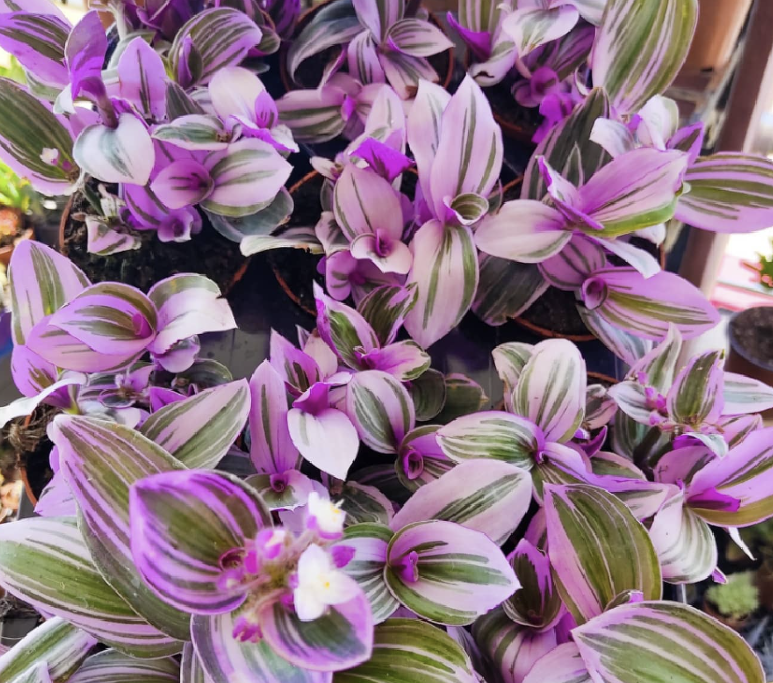The Wandering Jew plant is a stunning addition to any indoor or outdoor space.
With its vibrant foliage, trailing long stems, and relatively easy care routine, it’s no surprise that it’s a popular houseplant among beginners and experienced plant lovers alike.
The term “Wandering Jew” is a common name historically used to refer to several species within the Tradescantia genus, like Tradescantia zebrina, Tradescantia pallida, or Tradescantia fluminensis.
This guide will help you understand everything you need to know to keep your plant happy and thriving.
How to Identify
The Wandering Jew plant is known for its striking purple stripes, silver accents, and green leaves that shimmer in the light.
Its leaves are slightly pointed, and the plant’s growth habit includes trailing long stems that make it perfect for hanging baskets or as a cascading feature in indoor spaces.
Different varieties, like the Tradescantia nanouk and purple heart, showcase unique color patterns and textures, adding variety to your plant collection.
Size
This plant typically grows to about 6–9 inches tall, but its trailing stems can reach several feet long.
Its compact height and ability to spread make it a great choice for both small indoor spaces and larger areas where it can serve as a ground cover.
The Different Types
The Tradescantia genus features several different species, each with its own unique characteristics. Here are some popular types:
- Tradescantia zebrina: Features purple stripes with green and silver highlights.
- Tradescantia pallida (Purple Heart): Known for its solid purple, elongated leaves.
- Tradescantia fluminensis: Often used as an outdoor plant or ground cover, with more delicate green leaves.
Light
Bright indirect light is ideal for keeping the vibrant colors of a Wandering Jew plant. Sunlight will also keep it bushy and full shape wise. Too much sunlight can scorch its leaves, while little light can make the plant leggy and dull.
For best results, place your plant near a south-facing window with filtered light or an area with plenty of indirect sunlight.
Tip: Keep in mind that this plant naturally becomes leggy over time, but proper lighting can slow this process and encourage a fuller, bushier appearance.
Water
Remember that these plants absolutely love water. They have thin roots so dry soil is a big no. Keep the soil consistently moist but not soggy. If you keep this plant too dry, you will have crispy leaves. Water thoroughly when the top inch of soil feels dry. Give it a good soak, but make sure the water comes through the drainage holes.
During the growing season (spring and summer), you might need to water more frequently. Reduce watering in the winter months, as the plant’s growth slows.
Tip: Use a jar of water to propagate cuttings while watering less during colder months to prevent soggy soil or yellow leaves.
Temperature
The Wandering Jew thrives in warm temperatures between 65°F and 75°F (18°C–24°C).
Avoid exposing it to drafts, air conditioning, or temperatures below 50°F (10°C), as it’s sensitive to colder climates.
Humidity
This tropical plant loves high humidity, so consider placing it in areas like kitchens or bathrooms.
If your home is dry, use a small humidifier, mist the leaves lightly, or set up a humidity tray to mimic its natural environment.
Tip: Higher humidity helps prevent issues like brown leaves and supports new growth.
Soil
Use a regular potting mix with added organic matter, coco coir, or coarse sand to improve drainage. The soil should retain moisture without becoming waterlogged.
A well-draining soil prevents root rot and ensures a healthy root system.
Fertilizer
Feed your Wandering Jew with a water-soluble fertilizer once a month during the growing season. These are fast growing plant, which love fertiliser.
This helps maintain its vibrant foliage and encourages new leaves. Avoid over-fertilizing, as this can lead to nutrient deficiencies or weak growth.
Potting
Repot your plant every 1–2 years or when it outgrows its pot.
Choose a larger pot with drainage holes to accommodate its expanding root ball. Spring is the best time to repot, as the plant is actively growing.
Where to Place It in a Home
The Wandering Jew plant thrives in indoor spaces with ample bright light.
Consider hanging it in a hanging basket near a south-facing window or placing it on a shelf where its long stems can trail gracefully.
Avoid spots with harsh, direct sunlight or drafts.
Pruning
In the wild, this plant would grow along the floor and will root where they touch the soil.
Regular pruning helps maintain the plant’s shape and encourages bushiness. Remove lower leaves and trim long stems that have become leggy.
You can replant the cuttings in the same pot to make the plant fuller.
Tip: Wandering Jew plants will need to be cut back to retain their bushy appearance. But, you can put the cuttings back into the soil, and they’ll grow, which will make the plant fuller.
Propagation
These plants are really easy to propagate!
The best way to propagate a Wandering Jew is through stem cuttings:
- Cut a healthy stem just below a leaf node (around 2-3 inches in size).
- Place the cutting in a glass of water or directly in moist soil.
- Roots will develop in about a week, allowing you to pot the new plant.
Propagation is a great way to expand your collection or share new plants with friends.
You can also add the stem back to the original pot with the parent plant for a fuller-looking plant.
Pests
Although generally hardy, the Wandering Jew can attract spider mites, mealybugs, and aphids. These pests can be controlled using neem oil or an insecticidal soap.
Keep humidity high to deter pest infestations, as dry conditions encourage mites.
Diseases
Common diseases include:
- Root Rot: Prevent by avoiding overwatering and ensuring good drainage.
- Powdery Mildew: Improve airflow and avoid overhead watering to prevent this fungal issue.
Is It Toxic?
The Wandering Jew plant can cause skin irritation in humans and may be mildly toxic to pets if ingested. Always keep it out of reach of curious children and animals.
Common Issues and How to Fix Them
- Leggy Growth: Make sure it’s getting plenty of light, this will keep it colourful, and bushy instead of leggy. Tradescantias naturally get leggy and parts die. They’re still beautiful and its great for propagation.
- Yellow Leaves: Caused by excess water or lack of light.
- Brown Leaves: Often a result of low humidity or nutrient deficiencies.
Difficulty Level
The Wandering Jew plant is one of the easiest plants to care for, making it perfect for beginners and advanced gardeners. With proper lighting, watering, and occasional pruning, it’s a low-maintenance addition to any home.
Caring for a Wandering Jew plant is a rewarding experience. With its vibrant colours, fast growth, and ease of propagation, it’s no wonder this perennial plant is beloved by so many.
Whether you’re a seasoned plant lover or new to the hobby, this guide will ensure your Tradescantia plants remain healthy and beautiful. Overall, it’s a pretty easy and fun plant!
Frequently Asked Questions
Why is my Wandering Jew plant so leggy?
A leggy Wandering Jew plant is usually a result of insufficient light. When the plant doesn’t receive enough bright indirect light, it stretches toward the light source, leading to sparse, elongated stems. To fix this, move your plant to a brighter location, such as near a south-facing window, or consider using a grow lamp to provide the right amount of light. Regular pruning can also help encourage bushier growth.
Why is my Wandering Jew plant dying?
Common reasons for a dying Wandering Jew plant include:
- Overwatering, leading to root rot. Ensure the plant is in well-draining soil and the pot has drainage holes.
- Underwatering, causing wilting or dry leaves. Water the plant when the top inch of soil feels dry.
- Low humidity, especially in winter. Increase humidity using a small humidifier or by misting the plant.
- Pests, such as spider mites or mealybugs. Inspect the plant and treat infestations with neem oil or insecticidal soap.
Why is my Wandering Jew plant losing color?
Color loss is often due to a lack of light. The vibrant purple stripes and green leaves fade when the plant doesn’t get enough bright indirect light. Move your plant closer to a light source or a south-facing window to restore its vibrant appearance. Excess water and nutrient deficiencies can also dull the plant’s colors. Use a balanced, water-soluble fertilizer during the growing season to support its health.
Why is my Wandering Jew plant flowering?
The Wandering Jew plant flowers when it’s thriving in the right conditions, such as bright light, warm temperatures, and regular watering. Its small, delicate flowers are a sign of good health, but some plant owners focus more on maintaining the foliage, as the blooms are relatively insignificant compared to the plant’s colorful leaves.
What does the color of my Wandering Jew plant mean?
- Purple: Healthy, well-lit conditions are ideal for maintaining vibrant purple stripes or solid purple foliage (depending on the variety).
- Yellow: A sign of overwatering, poor drainage, or nutrient deficiencies. Check soil moisture and reduce watering if necessary.
- Green: Normal for some varieties, but if a purple variety turns mostly green, the plant may need more light to bring back its vibrant color.
- Brown: Usually caused by low humidity, pest infestations, or excess sunlight. Check for dry air or pests and adjust conditions.
How to make a Wandering Jew plant bushy?
To encourage a fuller, bushier plant:
- Prune regularly: Trim back long stems and pinch off the tips of new growth to stimulate branching.
- Propagate cuttings: Plant the cuttings back into the soil to fill out sparse areas.
- Ensure the plant gets enough bright indirect light to avoid legginess.
💡 Tip: Regular pruning not only keeps the plant bushy but also maintains its vibrant appearance.
How to propagate a Wandering Jew plant in water compared to soil?
- In Water:
- Cut a healthy stem just below a leaf node.
- Remove the lower leaves and place the stem in a glass of water.
- Change the water every few days, and roots will appear in about 1–2 weeks.
- In Soil:
- Take a cutting and plant it directly in moist soil.
- Keep the soil consistently damp until roots establish.
Propagation in water allows you to see root growth, while soil propagation is quicker for planting directly into a pot.
When to repot a Wandering Jew plant?
Repot your Wandering Jew plant every 1–2 years or when it outgrows its container. The best time to repot is during the growing season (spring or early summer). Use a slightly larger pot with well-draining soil and ensure the pot has drainage holes.
Can pets eat Wandering Jew plant?
The Wandering Jew plant can cause skin irritation and mild toxicity in pets if ingested. Keep it out of reach of cats, dogs, and other animals. Contact a vet if your pet shows signs of irritation or discomfort.
Can I put a Wandering Jew plant outside?
Yes, the Wandering Jew plant can be grown outdoors in USDA hardiness zones 9–11 or warmer regions. In cooler areas, you can move it outdoors during the summer, but bring it back inside before temperatures drop below 50°F (10°C).
Can the Wandering Jew plant survive winter?
In colder climates, the Wandering Jew plant cannot survive freezing temperatures. Keep it indoors in a warm spot during the winter months with adequate light and humidity. Reduce watering during this time to prevent root rot caused by slower growth.

